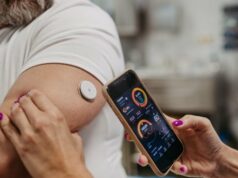
Further development on a prototype of a pioneering glucose monitoring system has been given the go ahead after it was tested on a human being.
Swedish researchers have created a microneedle patch with needles that are 50 times smaller than the needles used in the insertion of conventional continuous glucose monitoring (CGM) systems. The team working on the device is from the KTH Royal Institute of Technology in Stockholm.
CGMs take glucose readings from interstitial fluid which acts as a reservoir for nutrients including glucose. The level of glucose in interstitial fluid increases and decreases in close proportion to that of blood glucose. However, there is a delay, typically of about 10-15 minutes between the changes in blood glucose and the level of glucose in interstitial fluid.
The researchers note that microneedles allow the sensor to be closer to the mesh of blood vessels under the skin. The hope is this may provide an even greater level of accuracy than current CGMs can provide.
They have found that combining the patch and a tiny three-electrode enzymatic sensor has already shown to be effective in correctly tracking glucose levels over time when applied to a person’s arm.
They are now looking to further their design and find a way to develop a transferable adhesive patch, complete with algorithms and electronics, which can be tested in a clinical trial.
One of the researchers, doctoral student Federico Ribet, said: “Our solution is painless to the user. We measure directly in the skin, and there are no nerve receptors that detect pain – just a fine mesh of very tiny blood vessels.
“An important distinction is that unlike commercially available CGMS which measure the subcutaneous fat tissue, ours measures within the skin less than 1mm deep, where the interstitial fluid follows closer and more homogeneously the blood-glucose oscillations.”
The team’s goal is to develop the product, so it equals or surpasses current CGM devices, that are factory calibrated and reduces the frequency of having to perform a finger-prick blood glucose test.







